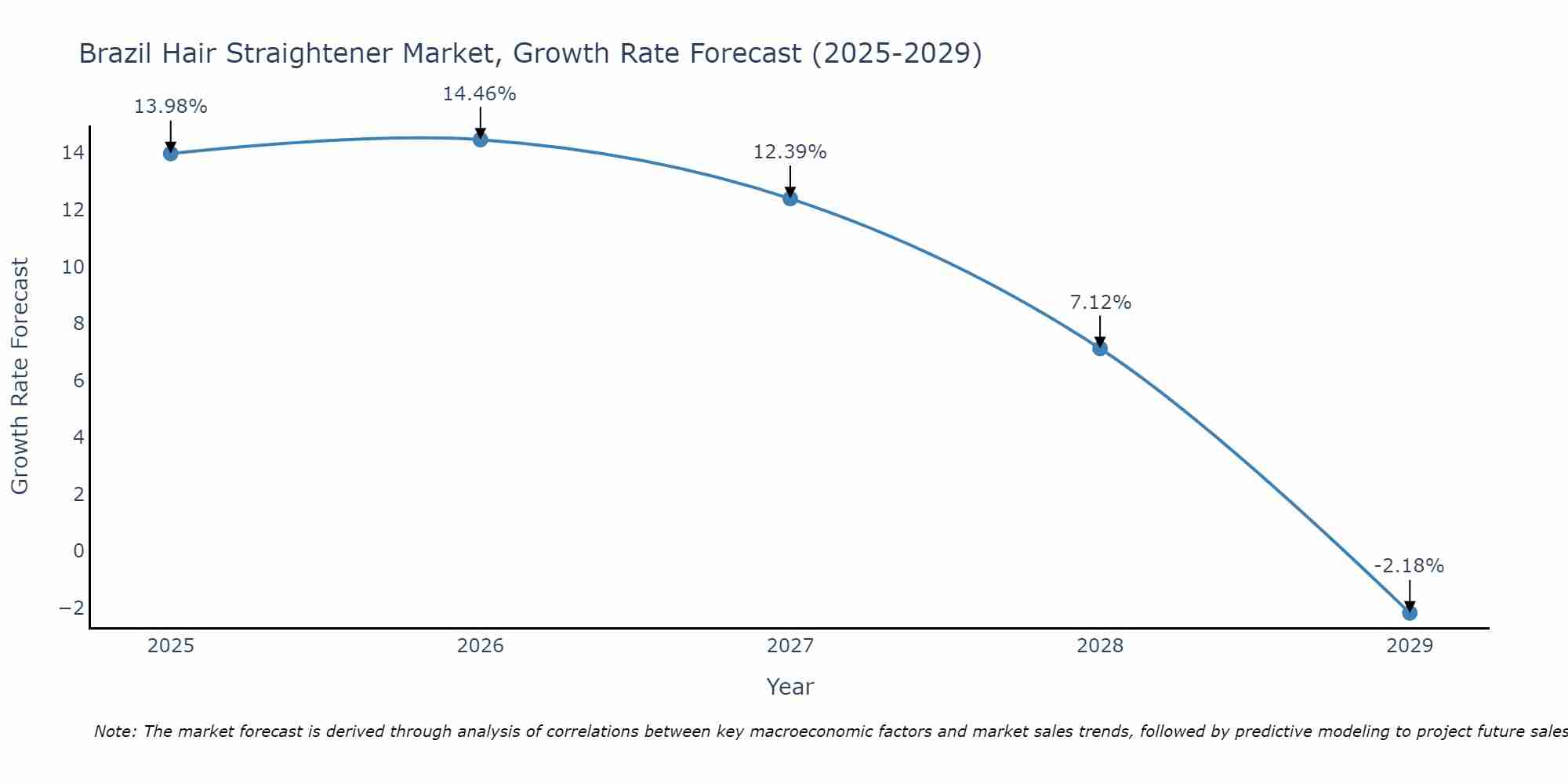Brazil Hair Straightener Market Outlook | Share, Companies, Forecast, Revenue, Growth, Size, Analysis, Trends, COVID-19 IMPACT, Value & Industry
| Product Code: ETC327302 | Publication Date: Aug 2022 | Updated Date: Apr 2025 | Product Type: Market Research Report | |
| Publisher: 6Wresearch | Author: Shubham Padhi | No. of Pages: 75 | No. of Figures: 35 | No. of Tables: 20 |
Brazil Hair Straightener Market Size Growth Rate
The Brazil Hair Straightener Market is projected to witness mixed growth rate patterns during 2025 to 2029. Starting at 13.98% in 2025, the market peaks at 14.46% in 2026, and settles at -2.18% by 2029.

Brazil Hair Straightener Market Overview
The hair straightener market in Brazil offers heat styling tools and devices designed to straighten and smooth curly or wavy hair textures. With Brazil diverse hair types and styling preferences, this market includes hair straightening irons, flat irons, and hair straightening brushes equipped with ceramic, tourmaline, or titanium plates. Hair straighteners provide individuals with salon-quality results at home, offering convenience and control over their hair styling routines. Manufacturers focus on developing hair straighteners with advanced heat settings, safety features, and ergonomic designs to minimize heat damage and maximize styling efficiency.
Drivers of the market
The Brazil Hair Straightener Market experiences growth driven by several key factors. Firstly, the increasing desire for sleek and straight hairstyles fuels market growth. Hair straighteners, also known as flat irons, are widely used by individuals with curly, wavy, or frizzy hair to achieve a smooth and straightened look. Additionally, the influence of fashion trends, celebrity endorsements, and social media drives the demand for hair straightening products. Moreover, advancements in hair straightener technology such as ceramic plates, tourmaline coatings, and adjustable heat settings enhance product performance and user experience, further driving market expansion. Furthermore, the expanding availability of hair straighteners in retail outlets, online platforms, and professional salons contributes to market growth in Brazil.
Challenges of the market
The hair straightener market in Brazil faces challenges associated with product safety, regulatory compliance, and technological advancements. Regulatory agencies impose stringent standards on hair straightener formulations and manufacturing processes to ensure consumer safety and product efficacy, requiring companies to invest in research and development to meet these requirements. Moreover, technological innovations in hair straightening devices and techniques drive market dynamics, necessitating continuous product improvements and adaptation to changing consumer preferences. Balancing innovation with regulatory compliance and consumer expectations presents ongoing challenges for stakeholders in the Brazil hair straightener market.
Government Policy of the market
Government regulations in Brazil concerning the hair straightener market may include standards for product safety, labeling requirements, and usage guidelines. Policies aim to ensure the safety and efficacy of hair straighteners, particularly in preventing heat damage and chemical burns to hair and scalp.
Key Highlights of the Report:
- Brazil Hair Straightener Market Outlook
- Market Size of Brazil Hair Straightener Market, 2024
- Forecast of Brazil Hair Straightener Market, 2031
- Historical Data and Forecast of Brazil Hair Straightener Revenues & Volume for the Period 2018 - 2031
- Brazil Hair Straightener Market Trend Evolution
- Brazil Hair Straightener Market Drivers and Challenges
- Brazil Hair Straightener Price Trends
- Brazil Hair Straightener Porter's Five Forces
- Brazil Hair Straightener Industry Life Cycle
- Historical Data and Forecast of Brazil Hair Straightener Market Revenues & Volume By Plate Type for the Period 2018 - 2031
- Historical Data and Forecast of Brazil Hair Straightener Market Revenues & Volume By Ceramic for the Period 2018 - 2031
- Historical Data and Forecast of Brazil Hair Straightener Market Revenues & Volume By Titanium for the Period 2018 - 2031
- Historical Data and Forecast of Brazil Hair Straightener Market Revenues & Volume By Tourmaline for the Period 2018 - 2031
- Historical Data and Forecast of Brazil Hair Straightener Market Revenues & Volume By Others for the Period 2018 - 2031
- Historical Data and Forecast of Brazil Hair Straightener Market Revenues & Volume By End User for the Period 2018 - 2031
- Historical Data and Forecast of Brazil Hair Straightener Market Revenues & Volume By Household for the Period 2018 - 2031
- Historical Data and Forecast of Brazil Hair Straightener Market Revenues & Volume By Commercial for the Period 2018 - 2031
- Historical Data and Forecast of Brazil Hair Straightener Market Revenues & Volume By Distribution Channel for the Period 2018 - 2031
- Historical Data and Forecast of Brazil Hair Straightener Market Revenues & Volume By Offline Store for the Period 2018 - 2031
- Historical Data and Forecast of Brazil Hair Straightener Market Revenues & Volume By Online Store for the Period 2018 - 2031
- Brazil Hair Straightener Import Export Trade Statistics
- Market Opportunity Assessment By Plate Type
- Market Opportunity Assessment By End User
- Market Opportunity Assessment By Distribution Channel
- Brazil Hair Straightener Top Companies Market Share
- Brazil Hair Straightener Competitive Benchmarking By Technical and Operational Parameters
- Brazil Hair Straightener Company Profiles
- Brazil Hair Straightener Key Strategic Recommendations
Frequently Asked Questions About the Market Study (FAQs):
1 Executive Summary |
2 Introduction |
2.1 Key Highlights of the Report |
2.2 Report Description |
2.3 Market Scope & Segmentation |
2.4 Research Methodology |
2.5 Assumptions |
3 Brazil Hair Straightener Market Overview |
3.1 Brazil Country Macro Economic Indicators |
3.2 Brazil Hair Straightener Market Revenues & Volume, 2021 & 2031F |
3.3 Brazil Hair Straightener Market - Industry Life Cycle |
3.4 Brazil Hair Straightener Market - Porter's Five Forces |
3.5 Brazil Hair Straightener Market Revenues & Volume Share, By Plate Type, 2021 & 2031F |
3.6 Brazil Hair Straightener Market Revenues & Volume Share, By End User, 2021 & 2031F |
3.7 Brazil Hair Straightener Market Revenues & Volume Share, By Distribution Channel, 2021 & 2031F |
4 Brazil Hair Straightener Market Dynamics |
4.1 Impact Analysis |
4.2 Market Drivers |
4.3 Market Restraints |
5 Brazil Hair Straightener Market Trends |
6 Brazil Hair Straightener Market, By Types |
6.1 Brazil Hair Straightener Market, By Plate Type |
6.1.1 Overview and Analysis |
6.1.2 Brazil Hair Straightener Market Revenues & Volume, By Plate Type, 2021-2031F |
6.1.3 Brazil Hair Straightener Market Revenues & Volume, By Ceramic, 2021-2031F |
6.1.4 Brazil Hair Straightener Market Revenues & Volume, By Titanium, 2021-2031F |
6.1.5 Brazil Hair Straightener Market Revenues & Volume, By Tourmaline, 2021-2031F |
6.1.6 Brazil Hair Straightener Market Revenues & Volume, By Others, 2021-2031F |
6.2 Brazil Hair Straightener Market, By End User |
6.2.1 Overview and Analysis |
6.2.2 Brazil Hair Straightener Market Revenues & Volume, By Household, 2021-2031F |
6.2.3 Brazil Hair Straightener Market Revenues & Volume, By Commercial, 2021-2031F |
6.3 Brazil Hair Straightener Market, By Distribution Channel |
6.3.1 Overview and Analysis |
6.3.2 Brazil Hair Straightener Market Revenues & Volume, By Offline Store, 2021-2031F |
6.3.3 Brazil Hair Straightener Market Revenues & Volume, By Online Store, 2021-2031F |
7 Brazil Hair Straightener Market Import-Export Trade Statistics |
7.1 Brazil Hair Straightener Market Export to Major Countries |
7.2 Brazil Hair Straightener Market Imports from Major Countries |
8 Brazil Hair Straightener Market Key Performance Indicators |
9 Brazil Hair Straightener Market - Opportunity Assessment |
9.1 Brazil Hair Straightener Market Opportunity Assessment, By Plate Type, 2021 & 2031F |
9.2 Brazil Hair Straightener Market Opportunity Assessment, By End User, 2021 & 2031F |
9.3 Brazil Hair Straightener Market Opportunity Assessment, By Distribution Channel, 2021 & 2031F |
10 Brazil Hair Straightener Market - Competitive Landscape |
10.1 Brazil Hair Straightener Market Revenue Share, By Companies, 2024 |
10.2 Brazil Hair Straightener Market Competitive Benchmarking, By Operating and Technical Parameters |
11 Company Profiles |
12 Recommendations |
13 Disclaimer |
- Single User License$ 1,995
- Department License$ 2,400
- Site License$ 3,120
- Global License$ 3,795
Search
Related Reports
- Portugal Electronic Document Management Market (2025-2031) | Strategy, Consumer Insights, Analysis, Investment Trends, Opportunities, Growth, Size, Share, Industry, Revenue, Segments, Value, Segmentation, Supply, Forecast, Restraints, Outlook, Competition, Drivers, Trends, Demand, Pricing Analysis, Competitive, Strategic Insights, Companies, Challenges
- France Electronic Document Management Market (2025-2031) | Strategy, Consumer Insights, Analysis, Investment Trends, Opportunities, Growth, Size, Share, Industry, Revenue, Segments, Value, Segmentation, Supply, Forecast, Restraints, Outlook, Competition, Drivers, Trends, Demand, Pricing Analysis, Competitive, Strategic Insights, Companies, Challenges
- Portugal Occupational Health & Safety Services Market (2025-2031) | Strategy, Consumer Insights, Analysis, Investment Trends, Opportunities, Growth, Size, Share, Industry, Revenue, Segments, Value, Segmentation, Supply, Forecast, Restraints, Outlook, Competition, Drivers, Trends, Demand, Pricing Analysis, Competitive, Strategic Insights, Companies, Challenges
- Netherlands Occupational Health and Safety Services Market (2025-2031) | Strategy, Consumer Insights, Analysis, Investment Trends, Opportunities, Growth, Size, Share, Industry, Revenue, Segments, Value, Segmentation, Supply, Forecast, Restraints, Outlook, Competition, Drivers, Trends, Demand, Pricing Analysis, Competitive, Strategic Insights, Companies, Challenges
- Belgium and Luxembourg Facility Management Market (2025-2031) | Strategy, Consumer Insights, Analysis, Investment Trends, Opportunities, Growth, Size, Share, Industry, Revenue, Segments, Value, Segmentation, Supply, Forecast, Restraints, Outlook, Competition, Drivers, Trends, Demand, Pricing Analysis, Competitive, Strategic Insights, Companies, Challenges
- Russia Women Intimate Apparel Market (2025-2031) | Strategy, Consumer Insights, Analysis, Investment Trends, Opportunities, Growth, Size, Share, Industry, Revenue, Segments, Value, Segmentation, Supply, Forecast, Restraints, Outlook, Competition, Drivers, Trends, Demand, Pricing Analysis, Competitive, Strategic Insights, Companies, Challenges
- Africa Chocolate Market (2025-2031) | Size, Share, Trends, Growth, Revenue, Analysis, Forecast, industry & Outlook
- Global Hydroxychloroquine And Chloroquine Market (2025-2031) | Industry, Trends, Size, Outlook, Growth, Value, Companies, Revenue, Analysis, Share, Forecast
- Saudi Arabia Plant Maintenance Market (2025-2031) | Industry, Size, Growth, Revenue, Value, Companies, Forecast, Analysis, Share & Trends
- Taiwan Electric Truck Market (2025-2031) | Outlook, Industry, Revenue, Size, Forecast, Growth, Analysis, Share, Companies, Value & Trends
Industry Events and Analyst Meet
Our Clients
Whitepaper
- Middle East & Africa Commercial Security Market Click here to view more.
- Middle East & Africa Fire Safety Systems & Equipment Market Click here to view more.
- GCC Drone Market Click here to view more.
- Middle East Lighting Fixture Market Click here to view more.
- GCC Physical & Perimeter Security Market Click here to view more.
6WResearch In News
- Doha a strategic location for EV manufacturing hub: IPA Qatar
- Demand for luxury TVs surging in the GCC, says Samsung
- Empowering Growth: The Thriving Journey of Bangladesh’s Cable Industry
- Demand for luxury TVs surging in the GCC, says Samsung
- Video call with a traditional healer? Once unthinkable, it’s now common in South Africa
- Intelligent Buildings To Smooth GCC’s Path To Net Zero













